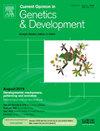3D基因组折叠的深度学习模型的配方和成分。
IF 3.6
2区 生物学
Q2 CELL BIOLOGY
引用次数: 0
摘要
三维基因组折叠在基因调控和疾病中发挥作用。在这篇综述中,我们比较和对比了最近用于预测基因组接触图谱的深度学习模型。我们调查了预处理、架构、训练、评估和解释方法,强调了不同模型的功能和局限性。在每个领域,我们都强调了基因组折叠模型的挑战、机遇和潜在的未来方向。本文章由计算机程序翻译,如有差异,请以英文原文为准。
Recipes and ingredients for deep learning models of 3D genome folding
Three-dimensional genome folding plays roles in gene regulation and disease. In this review, we compare and contrast recent deep learning models for predicting genome contact maps. We survey preprocessing, architecture, training, evaluation, and interpretation methods, highlighting the capabilities and limitations of different models. In each area, we highlight challenges, opportunities, and potential future directions for genome-folding models.
求助全文
通过发布文献求助,成功后即可免费获取论文全文。
去求助
来源期刊
CiteScore
7.90
自引率
0.00%
发文量
102
审稿时长
1 months
期刊介绍:
Current Opinion in Genetics and Development aims to stimulate scientifically grounded, interdisciplinary, multi-scale debate and exchange of ideas. It contains polished, concise and timely reviews and opinions, with particular emphasis on those articles published in the past two years. In addition to describing recent trends, the authors are encouraged to give their subjective opinion of the topics discussed.
In Current Opinion in Genetics and Development we help the reader by providing in a systematic manner:
1. The views of experts on current advances in their field in a clear and readable form.
2. Evaluations of the most interesting papers, annotated by experts, from the great wealth of original publications.[...]
The subject of Genetics and Development is divided into six themed sections, each of which is reviewed once a year:
• Cancer Genomics
• Genome Architecture and Expression
• Molecular and genetic basis of disease
• Developmental mechanisms, patterning and evolution
• Cell reprogramming, regeneration and repair
• Genetics of Human Origin / Evolutionary genetics (alternate years)

 求助内容:
求助内容: 应助结果提醒方式:
应助结果提醒方式:


